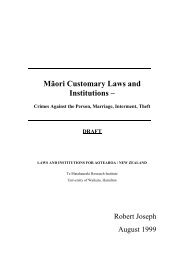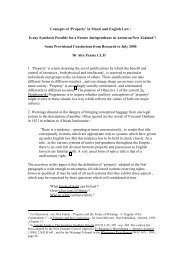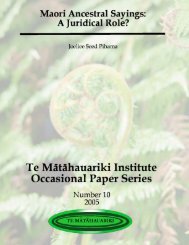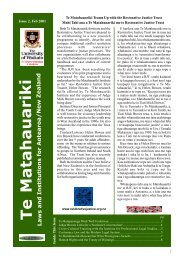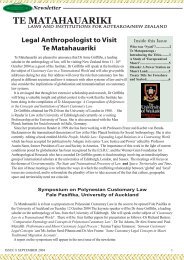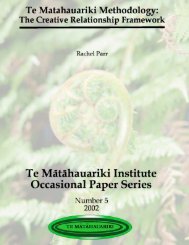Te Matahauariki Institute Newsletter - LIANZ
Te Matahauariki Institute Newsletter - LIANZ
Te Matahauariki Institute Newsletter - LIANZ
Create successful ePaper yourself
Turn your PDF publications into a flip-book with our unique Google optimized e-Paper software.
<strong>Te</strong> <strong>Matahauariki</strong>Issue 1, Nov 2000Laws and Institutions for Aotearoa/New ZealandIntroductory Comment He Kupu WhakatakiGreetings and salutations!This is the first issue of a quarterlynewsletter to keep you informed of ourcontinuing programme of research whichexamines a question central to contemporaryconstitutional and political debatesin New Zealand: If laws andinstitutions shape and reflect thevalues of a society, do the laws andinstitutions of New Zealand adequatelyfulfill that role? Theprogramme does not aim to answer thisfundamental question, but rather to buildup a body of soundly based data, knowledgeand commentary to inform an essentialnational discourse.To date the project has enabled theresearchers to address methodology,lessons to be learned from models inother jurisdictions and historical informationrelating to Maori jurisprudence andearly Maori-Pakeha interaction. Withcontinued generous fundingfrom the Foundation for ScienceResearch and <strong>Te</strong>chnology,projects for the next phaseof the programme will includean investigation of commonground between Maori andPakeha, a reference work ofMaori jurisprudence and a practical guideto restorative justice.The research collated will serve toinform, sharpen and facilitate public conversationaround the development of aninclusive jurisprudence and institutionswhich will promote social cohesion.We are aware that the dualism of thepast (and indeed, in much present-daydiscussion and scholarship) is unhelpfuland untrustworthy in facilitating such cohesion.Nevertheless, we remain committedto the overall objective of findingand indeed strengthening the points ofconvergence, so that unity and diversitycan coexist in a creative rather than oppositionaltension.Central to achieving that objective isthe continued support of an AdvisoryPanel of eminent experts drawn from thejudiciary, leading academic and public institutionsand the private sector. We havealso held consultative meetings and seminarswith Maori experts. I remain gratefulfor such support and look forward to<strong>Te</strong>na koutou katoa.Koinei te putanga tuatahi o te panuika puta i ia hauwha-a-tau kia mohio aikoutou ki nga rangahau o <strong>Te</strong><strong>Matahauariki</strong>. He mea ata titiro ki tetahipatai nui e pa ana ki te tautohetohe mote mana motuhake me te manawhakaharere i Aotearoa nei, ara: Mena,kei te whakatinanatia e te ture me onawhare nga tikanga o te iwi, e peneiana ki Aotearoa nei? Heoti, ehara mamatou hei whakautu i tenei patai nuiwhakahirahira, engari ma te motu whanuihei wananga. Ko ta matou, hewhakaemiemi korero, matauranga tikahoki kia pai ai te rere o taua whakawhitiwhakaaro, koreroI tenei wa kua tirohia e matou ngahuarahi rangahau hei whai, nga tauira oetahi atu iwi, nga korero tawhito e hangaiana ki nga tikanga Maori, me ngaahuatanga o te nohotahi o te Maori ki tePakeha ki mua ra. Na te nui ote aroha o Tuapapa TohaPütea, Whakatakoto KaupapaRangahau, Putaiao kua taea tewahanga tuatoru o te kaupapanei, ara, he tirohanga ki ngaoritenga i waenga i te Pakehame te Maori, he matapunengao nga ture/tikanga Maori, a, he pukapukatohutohu i nga ahuatanga o te tikangawhakawa, whakatika.Ma nga kohinga rangahau ewhakamohio atu, e whakangawari ake temahi wananga i te iwi whanui i te takewhakatupu ake i te ture me ona wharehei whakapumau i te whanaungatangaki waenga i nga iwi.E mohio ana matou na te nohoweherua i mua (me enei ra hoki) i kotitiai te nohotahi. Otira, e mau pumau anamatou ki tenei kaupapa nei, ara, kiakimihia, kia whakamarohia hoki i te tauratangata kia kore ai e motu.Ko te mea nui hei whakatutuki i tekaupapa, ko te tautoko o nga pukenga, onga tohunga i ahu mai ai i te rarangi Tiati,i nga whare wananga, i nga tarikawanatanga, i nga umanga ake hoki.Kua huihui hoki matou ki te taha o ngaPukenga Maori. E mihi kau ana ki taratou tautoko, a, ko te tumanako ka peneitonu te piri tahi haere ake nei.I nga marama kei te heke mai, ka1
an ongoing relationship.Over the next few months we willbe putting out occasional papers andmonographs for public comment. Abook is also in the pipeline. In themeantime I invite you to visit and linkup to our website atwww.lianz.waikato.ac.nzJudge MickBrownProject Leadertohatoha matou i etahi pepa hei tirotiroma koutou. Ma te wa hoki ka putahe pukapuka. Heoi ano, mo tenei wae inoi ana kia toro mai ki ta matou wahiipurangi ki www.lianz.waikato.a.nz.Noho ora mai ra.Na Tiati Miki Paraone<strong>Te</strong> Kaihautu.Issue 1, Nov 2000Collaborative Cross-Cultural ResearchKia Rangahau Ngatahi, Maori me te PakehaObjective 1 of the researchprogramme, 'Bicultural Methodologyand Consultative Processes', requiredthat we identify the range of methodologiesand consultative processes forbicultural socio-legal evaluative research.Drawing from work to date in theprogramme it became apparent thatwhile kaupapa Maori is indeed acentral part of our research activity,our wider kaupapa is Maori-Pakehacross-cultural collaboration. Werealised that the task of the developmentof an inclusive jurisprudence andinstitutions that will promote social cohesionis one for all New Zealanders.For either Maori or Pakeha not toparticipate is to abrogate their Treatyresponsibilities.To that end a summary paper forthe objective has been draftedhighlighting this key issue of collaborativecross-cultural research. Thepaper addresses research methodsand methodologies that engage andinclude both Maori and Pakeha insearch of not only divergence, but alsomore importantly, convergence. Thepaper argues that collaborative culturalresearch is about the bridgebuildingexercise. It is about producingknowledge that answers questions,where possible, for both Maori andPakeha about Maori and Pakehaworlds, Maori and Pakeha perspectives,Maori and Pakeha cultural practicesand values against a backgroundof trying not only to understand dif-Ko te tuatahi o nga whainga o tekaupapa nei he kimikimi i nga huarahipai mo te rangahau me te korero tahihei whai. He mea kia tutuki pai ai temahi rangahau i te ture na runga i ngatikanga rua.Kua kitea mai i nga mahi i mahia,ahakoa he wahanga nui ano to tekaupapa Maori ko te whanuitanga o<strong>Te</strong> <strong>Matahauariki</strong> ko te mahi tahi o teMaori me te Pakeha. Ma te kaupapanei e waihanga nga ture e mau ai temana o tena me tena. He kaupapatenei mo tatau katoa. Ki te kore teMaori me te Pakeha e whaiwahi kitenei kaupapa ka whakarere noa ihonga herenga ki te Tiriti o Waitangi.No kona, kua tuhia he pepa ewhakamarama ana i ta matau e whainei. Ka arohia tenei pepa ki ngawhainga rangahau e whakauru ai teMaori me te Pakeha, e rapu tahi nei inga rereketanga me nga oritenga. Kote matu o tenei pepa he whakakotahi.Me rangahau kaupapa heiwhakapuakitanga i nga whakaaro, heimatapihi tirohanga mo te Maori me tePakeha ki roto ki o ratou whare,ahakoa he rereke, he orite ranei. Mewaiho te kupu whakamutunga ki teruruhi ra, a Dame Joan Metge, nananei te kaupapa i tautoko, i awhina mai.“Ka whakarangatira tatou i a tatou,ka whakakoi ake, ka wero ake, a, katutu te puehu hoki. He pai ake te mahitahi i to te mahi weherua. Ma te mahitahi e marama ake ai, e paweraweraake ai te kaupapa.Tirohia mai te pepa nei kaore ano“If there is one thing a Nativeloves more than another it is aCourt case, and if there were onlyCourts above Courts, and otherCourts above them again whichthey can still carry their litigation,then it seems to them a matter ofabsolute enjoyment.”Wilford M.P., Hansard, 1912, p.941“Ki te Maori, kaore he aha i tuaatu i te take kooti e taea ana hokite kukume roa, atu ki te mutungakore.”Wilford, M.P., Pukapuka KoreroParemata, 1912, w.harangi 941.2
ference but also commonality betweenboth cultures. Dame JoanMetge who collaborated with us onthe paper in her final comment remindsus that, “we complement eachother. We also stimulate, challenge andstrike sparks off each other. We willunderstand more, explore more deeplyby working together than we couldever do separately”.A draft copy of the paper isavailable online for viewing atwww.lianz.waikato.ac.nz/pub1.html.We would welcome any feedback/comments. Please email these tomeredith@waikato.ac.nz.A Research Framework for Seeking Common GroundHe Tahuhu Rangahau mo te Rapunga i nga OritengaThe search for a common future inAotearoa/New Zealand has alwaysbeen the goal of the researchprogramme – hence its name: <strong>Te</strong><strong>Matahauariki</strong>. In this phase, however,our research on law and institutions isbeing even more consciously focusedwithin a framework entitled “SeekingCommon Ground”, where common isused both in the sense of unitingacross difference and of belonging tothe people.Within this theme of ‘commonground’ we have identified a numberof aspects:(1) Identifying and sourcingwhat is common: here we aim tobuild on earlier methodological andcomparative work, to identify the “values”of New Zealand Society onwhich the law is based and to considerother sources of “commonality”– the Treaty of Waitangi, the effectof 160 years of living together and theincreasing importance of internationallaw.(2) Constructing a commonframework that accommodatesdifference: here we aim to build onearlier examination of ways of accommodatingdifferent values and differentways of doing things. We seea number of topics on which work isplanned as fitting within this concept,kia tino oti i te ipurangi kiwww.lianz.waikato.ac.nz/pub1.html.Whakahokia mai koa ou whakaaro heitirohanga ma matou ki ameredith@waikato.ac.nz.Mai rano ko te rapunga i te hokaiwhakamua mo Aotearoa nei heiwhainga mo tenei kaupapa, ara kotona ingoa, ko <strong>Te</strong> <strong>Matahauariki</strong>. Itenei wahanga ake kua whaiti tetitiro ki raro i te tahuhu rangahaue kiia nei, “<strong>Te</strong> Rapunga i ngaOritenga”. He kaupapa heiwhakakotahi ma roto mai i ngamana motuhake me te manatangata.I tenei kaupapa kua kitea ematou enei ahuatanga e whai akenei:(1) E rapu ana i nga oritenga:he mea tapiri atu ki nga mahi o muakia tohua mai nga tikanga oAotearoa e noho papa ana mo ngature, a, he whai whakaro ki etahiatu matapuna mo te kaupapa nei,ara - ko te Tiriti o Waitangi, ko tekotahi rau ono tekau tau e nohotahi ana me ona piki me nga heke,a, ko nga take whakahirahira o teture no te ao whanui.(2) Ko te waihanga i tetahuhu whakakotahi e aro akenei ki te mana o tena, o tena:he tapiritanga tenei ki nga huarahikua tirohia mo te noho tahi, mahitahi hoki. He maha o matoukaupapa whai mahi e hangai anaki tenei ahuatanga pera i te 'restorativejustice' kei raro nei e korerotiaIssue 1, Nov 2000<strong>Te</strong> Waka Maori o Ahuriri,June 13, 1863 Vol 1, No. 1: 1"<strong>Te</strong>tahi painga o te nuipepapenei hei hono mo te Pakeha kote Maori. Hei whakaputangawhakaaro ma tatou, tetahi kitetahi; hei matapihi tirohangahoki ma tatou ki roto ki o tatouwhare – te Pakeha ki roto ki tote Maori, te Maori ki roto ki tote Pakeha. Inaianei e nohokuare noa ana te nuinga o tePakeha ki nga whakaaroMaori, me te Maori hoki e nohokuare noa ana ki nga whakaroo te Pakeha. Ka whai huarahihei whakapuakanga i o tatouwhakaaro, tetahi ki te reo otetahi, katahi ia ka tupu herongo pai kia tatou.""One benefit of a newspapersuch as this is the bringing togetherof Maori and Pakeha. Itallows the exchange ofthoughts; a window into eachothers world view - the Pakehalooking into that of the Maoriand the Maori into that of thePakeha. At present the majorityof Pakeha remain ingnorantof Maori views and vice versa.This is a way to effectively andproductively communicatingwith each other."3
<strong>Te</strong> Matapunenga:A Compendium of References to Customary Maori Legal ConceptsIssue 1, Nov 2000The Project is aimed at providinga base of knowledge about Maoricustomary law from which to advancethe <strong>Institute</strong>’s study of ways in whichour legal order can reflect the valuesof both of its major component cultures.As part of the <strong>Institute</strong>’sProgramme, the research team has setitself the task of compiling a referencework, named <strong>Te</strong> Matapunenga, whichwill attempt to bring together andpresent in accessible form thehistorical uses and meanings ofselected terms and concepts of Maoricustomary law.<strong>Te</strong> Matapunenga seeks to providealphabetically listed entries setting outthe terms and concepts of Maori customarylaw as they are recorded intraditional Maori accounts, and in historicalrecords both written and oral.Modern interpretations of the termsand concepts will also be noted whereappropriate. The contexts for thecited uses of the terms and conceptswill be provided wherever possible.Etymological information will beincluded, enabling links to words andtraditions in other parts of Polynesiato be traced, where these are known.Regional differences relating to customarylaw will also be noted. Of interestalso will be the manner in whichcustomary concepts have been recognizedor modified by the legislativeand judicial branches of the NewZealand government since 1840. Thecitations will provide a guide to leadingsources for further information undereach topic. Work on the entries hasbegun and will be linked to the<strong>Institute</strong>’s programme of consultationsand discussions with senior Maorischolars and leaders.It is envisaged that the ‘endusers’of<strong>Te</strong> Matapunenga will bemembers of Maori communities,students and scholars at all levelswithin New Zealand , Government atmany levels of policy and decisionmaking,and judicial officers acrossthe range of Courts and Tribunals. Itis also envisaged that the compilationwill be of interest to internationalscholars seeking an understanding ofHei ta <strong>Te</strong> <strong>Matahauariki</strong>, mo tewhakapae me whaiwhakaaro te tureme ona whare ki nga tikanga Maori omua, me ata mohio tatou i te tuatahiki aua tikanga Maori. Kei roto i omatau mahi kua whakaterea te wakae kiia nei ko <strong>Te</strong> Matapunenga. Hemahi whakaemiemi i nga korero monga tikanga Maori me onawhakamaramatanga hei whariki kimua i te motu.Ka whakararangitia e <strong>Te</strong>Matapunenga nga tikanga ki te pu retana runga ano i nga korero tawhito kuatuhia kua korerotia hoki. Kawhakahuatia hoki nga korero i takeamai i enei ra mena kei te hangai.Ka rau atu he horopaki tika mo ngakupu mena kei te hangai. Ka rau atuhoki nga hitoria o te kupu me tonawhakapapa ki nga kupu me ngatikanga o te Moana nui o Kiwa, menae mohiotia ana. Ka tirohia ki ngatikanga a iwi me te ahua o ta te turetitiro, whakamahi hoki ki nga tikangaMaori mai ano i te tau 1840. Ma iapitopito korero e here i te ihu ki ngapukenga korero. Kua timata ketia temahi wetewete korero, a, ka hono atuki tera kaupapa o te <strong>Matahauariki</strong>,ara, kia wananga tahitia ki ngatohunga Maori.E tumanako ana matou ka tukunatenei pukapuka kia panuitia e te iwiwhanui, nga tauira, nga pukenga hokiputa noa ki Aotearoa, tae atu ki ngakooti. Ko te tumanako hoki ka whaihua tenei mo nga pukenga o tawahi ehiahia ana ki te matauranga o tetikanga Maori.He mea whakaatu noa iho tenei inga korero. Ehara ma matou te ki mepenei, me pena tenei tikanga me tenatikanga hei ture. Ko ta matou noa ihohe whakaatu i nga korero hei tirohangamo ratou e hiahia nei ki te awhina itenei kaupapa wananga, ara, ko teahua o te ture me ona tikanga mo ngara kei te heke mai.He Muru[Artist unknown] :[A drawing of amuru at Parawera. Confronted bythe injured husband and wife,while the giddy dance proceeds infront of the marae. Between1860and 1890?]Source: Alexander TurnbullLibrary, Reference No. A-081-004See timeframes1.natlib.govt.nz/5
Maori customary law.<strong>Te</strong> Matapunenga will be primarilya descriptive work. It will not advocateany particular view as to any customor its place in the legal system.Nevertheless, the work will aimatproviding an authoritative point ofreference for those wishing to engagein the ongoing public discourse on thefuture shape of the legal system ofour country.Issue 1, Nov 2000He aha te Maoritanga? He Hui ki <strong>Te</strong> Kuiti i te tau 1911.What is Maoritanga? A Hui at <strong>Te</strong> Kuiti 1911"Ko tenei kupu ko te Maoritanga, me hanga he kupu tapu, me temana atua, pera me nga wa o muri e tokanuku ana nga pakeke, erautu ana te mana, e tapu ana te tangata."Ta Timi Carroll, 9.9.1911The coinage of the term Maoritangahas generally been attributed to SirJames Carroll in the 1920s. HoweverDame Evelyn Stokes has provided theProgramme with a transcript in Maoriof a gathering at <strong>Te</strong> Kuiti in 1911where a number of leaders havecome together in the spirit of unity tomake some determination as to themeaning of Maoritanga (although theearliest reference to date that we havefound concerning Maoritanga is1844). The author of the transcript isthe Ngati Matakore/Maniapotorangatira H.R.Wahanui.While Sir James Carroll is at theforefront of the discussion, others inattendance include Taonui Hikaka,Aprirana Ngata, <strong>Te</strong> Kahupukoro, Kipa<strong>Te</strong> Whatanui, Tuniarangi, PepneEketone and Heremia Tawake. Discussionincluded the role of the Maoripeople, status of the Maori language,culture and identity and relationshipwith laws and government. There arealso references to land developmentand grievances about confiscations inTaranaki, Waikato, Tauranga andWhakatane districts.The transcript is a significantcontribution to Maori scholarship andmembers of the Research <strong>Te</strong>am arecurrently working through the documentwith a view to publishing it andan associated analysis.Hei ta nga korero, na Ta Timi Karatenei kupu te Maoritanga i whakahuatuatahitia i nga tau 1920. Heoi ano,na Dame Evelyn Stokes i tuku maitetahi puka korero reo Maori mo tetahihuihuinga i <strong>Te</strong> Kuiti i te tau 1911. Ireira etahi Rangatira e huihui ana irunga i te whakaaro whakakotahi mete whai whakaaro mo te kupu o teMaoritanga. (ahakoa i kitea tuatahitiatenei kupu “Maoritanga” i te tau1844.) Ko H.R Wahanui te kaituhi inga korerorero, he rangatira ia noNgati Matakore me Ngati Maniapoto.Ahakoa ko Ta Timi Kara e hautuana i nga korero, i reira etahi atu ara,ko Taonui Hikaka, Apirana Ngata, <strong>Te</strong>Kahu Pukoro, Kipa <strong>Te</strong> Whatanui,Tunuiarangi, Pepene Eketone meHeremia Tawake. Ko nga kaupapakorero, ko te noho o te iwi Maori, temana o te reo, nga tikanga Maori meona panga ki te ture me teKawanatanga. He korero hoki e paana ki te mahi ahuwhenua, me ngatake raupatu i nga whenua o Taranaki,Waikato, Tauranga, Whakatane hoki.He mea whakahirahira tenei pukakorero hei tapiri atu ki nga pukengakorero a te Maori, a, kei te wewetehaere nga kaimahi o <strong>Te</strong> <strong>Matahauariki</strong>i te hohonutanga o tenei korero. Kote tumanako ka whakapukapukatia.The closest historical referencere mana whenua, mana moanafound to date:Elsdon Best quotes these commentsfrom <strong>Te</strong> Rangikaheke:‘The tumu on which Hinemoarested in Rotorua Lake was a post(or stake) erected in a shoal partof the lake. It was namedHinewhata and was erected as atoken of mana of Umukaria. Kawhiwhi te tino rangatiratanga i teone , whiwhi ana ki uta, whiwhiana ki te moana...’Letter to Solicitor-GeneralSalmond 5 October 1918 , NationalArchives , Wellington , File CLO174 Part 2.6
Issue 1, Nov 2000He Pitopito Korero mo te Kupu Mana: An Interesting Note on ‘Mana’In recent times debate has surrounded the meaning ofthe term iwi and its relationship to fish. However some100 years ago the major concern was the meaning of manaand land. The following was found as a newspaper clippingin W. H. Grace’s Diary 1882. It also appears in theAppendicies to the Journal of the House ofRepresentatives, 1890, G.-1 Opinions of Various Authoritieson Native <strong>Te</strong>nure.“We, the persons whose names are hereto attached,are aboriginal natives of New Zealand, who have beeninstructed in the Maori usages of our ancestors. We havealso traveled through various places in the islands of NewZealand, and know that the Maori usages observed byother tribes in no way differs from those of our districts.Now, this example is written by us for the considerationof the Judges of the Native Land Court in order that theymay know what the Maori custom is in relation to the“mana” of the chiefs of the Maori. That is to say, thereare many degrees of chieftainship, such as the superiorchief of a district, and the lesser ones of a hapu having itsown chief.(1) The superior chief of the large districts is the principalchief by descent and has great “mana” over the otherchiefs and tribes within the boundaries of the district underhis control (chieftainship). His “mana” is over the peopleonly, and does not affect the lands of those people; but hehas a claim to his own particular portion through his rightto the land if his occupation was derived from his ancestorsor his parents.(2) The lesser chiefs of the hapus; there are hapuswhose chief occupies the land belonging to him and hishapu. Such chiefs have a form of “mana” - that is, overtheir own hapu; but that mana does not confer (on him)the right to take the land of such hapu for himself. Butthat chief has a claim to the portion of land he has a rightto through ancestry, conquest, gift, or occupation from thetime of his ancestors down to himself whether large orsmall.(3) As for “mana” itself, unaccompanied with a rightto the land, a chief would not have a right to the landthrough “mana” alone.These are the “Maori” customs observed in the islandsof New Zealand in connection with “mana”. Now understandingas we do the customs of the “Maoris,” we havecorrectly set them forth herein, and we ask this exemplificationof ours be superadded to those examples alreadysupplied by the elders in the documents which are used asprecedents for the work of the Native Land Court of NewZealand. That this statement also be left as guiding principlewhereby the administration of the Judges of theNative Land Court for the future in dealing with usages ofthe Maori in relation to “mana” may be clear.”-Signed by Tamati Tautuhi, Hamuera mahupuku,Hoani Paraone, Tunuiarangi, Hemi matenga, WiParata, Kakakura, hone Omipi, Pepene Eketone,Hamiora mangakahia, Paratene Ngata.I enei ra kua tautohetohetia te whakamarama o te kupuiwi me tona herenga ki te ika. Engari kotahi rau tau kimua ko te maharahara nui, ko te whakamarama o te kupumana me te herenga ki te whenua. I kitea tenei e whaiake nei i tetahi niupepa e takoto ana i te rataka a W. H.Grace i te tau 1882. I kitea hoki i te Pukapuka Korero ote Paremata, 1890, G-1, Nga Whakaaro o Nga Pukengamo te Mana me te Whenua Maori.“Ko matou, ko nga tangata i tapirihia ai nga ingoa nei,he tangata whenua no Niu Tireni, he matatau hoki ki ngatikanga Maori a o matou tipuna. Kua takahia te mata o tewhenua nei, me te mohio hoki kaore he rereketanga onga tikanga o tena rohe, o tena rohe. <strong>Te</strong>na, he meawhakatauira tenei e matou mo nga tiati o te Kooti WhenuaMaori kia mohio ai ratou he aha nga tikanga e pa ana ki temana o nga rangatira Maori. Heoi ano ra, he maha ngaahuatanga o te rangatiratanga pera ano ki nga rangatiranona te mana nui me nga rangataira nona te mana iti.(1) Ko te rangataira nona te mana nui o te rohe whanuitonu kei a ia te mana whakaheke, a, ka noho tera aturangataira me nga hapu o taua rohe ki raro i tona mana.He mana tangata anake tona, kaore he whaipanga ki oratou whenua; engari e whaipanga ana ia ki tona akewhenua mena i whakaheke mai taua mana i ona matuatupuna.(2) Mo nga rangatira, no ratou te mana iti o nga hapu,ka noho ratou i runga i o ratou whenua ake. To ratoumana, kei runga noa iho i o ratou hapu. E koe e taea eratou te tango i nga whenua hapu mo ratou ake, engariano nga whenua i heke iho i o ratou tupuna ake mai i ngawhakapapa, raupatu, takoha, ahikaaroa, ahakoa iti, rahiranei.(3) Ki te kore he mana whenua, he mana tuku iho ranei,kua kore hoki he whai panga ki nga whenua. E kore etaea ma te mana anake.Koia nei nga tikanga Maori i kitea ki Niu Tireni e paana ki tenei mea ko te "mana". Na te mea e marama anamatou ki nga tikanga Maori, kua tika te whakatakoto, a, einoi atu kia tapirihia atu enei pitopito korero ki era kuahoraina ma e nga tupuna i roto i nga tuhinga tawhito heitaumata tohutohu ki te Kooti Whenua Maori o Niu Tirenii enei rangi. Ka waiho iho tenei korero hei pouherenga etaea ai e nga tiati te whakahaere pai i nga tikanga o teMaori e pa ana ki te mana."“By inserting a term like ‘mana whenua’ into public welfarelegislation, my deep fear is that we are handing overa customary concept with limited relevance in the modernfunction of society, handing over the definition, themeaning, the relevance of that customary concept to theHigh Court and to the legions of lawyers who currentlyfeast at the trough of the fisheries settlement.”Shane Jones, New Zealand Herald 8/8/20007
Issue 1, Nov 2000<strong>Te</strong> <strong>Matahauariki</strong> Online atwww.lianz.waikato.ac.nz<strong>Te</strong> <strong>Matahauariki</strong> i te Ipurangi kiwww.lianz.waikato.ac.nzResearchersNga KairangahauJudge Michael BrownTui AdamsProfessor Margaret BedggoodAssociate Professor Richard BentonProfessor Dame Evelyn StokesDr Alex FrameManuka HenareRobert JosephCatherine Iorns-MagallanesPaul MeredithGay MorganRachel ParrWayne RumblesTonga KarenaThe Advisory Panel<strong>Te</strong> Ropu KaitohutohuJustice David BaragwanathJustice Eddie DurieProfessor Mason H. DurieDenese HenareDr Dame Joan MetgeProfessor Wharehuia MilroyDavid OughtonDr Matthew PalmerProfessor Tamati ReedyProfessor James RitchieJudge Anand SatyanandProfessor Michael SelbyProfessor Richard SuttonSome Publications ForthcomingEtahi Pepa kei te Haere MaiDame Evelyn Stokes, Wiremu Tamihana <strong>Te</strong> Waharoa:A Study of his Life and Times.Dr Alex Frame, Property and the Treaty of Waitangi:A Tragedy of the Commodities?Rachel Parr and Paul Meredith, Collaborative Cross-Cultural Research for Laws and Institutions inAotearoa/New Zealand.Dame Joan Metge, Korero Tahi – Talking Together.Dame Evelyn Stokes, Tikanga Maori and GeothermalResources.Wayne Rumbles, Africa: Received and CustomaryLaw -Under One Umbrella.Robert Joseph, Historical Bicultural Development: ARecognition and Denial of Maori Custom in theColonial Legal System of Aotearoa/NewZealand.Dr Alexander Gillespie, Maori, Biodiversity andInternational Law.Dame Evelyn Stokes, Bicultural Methodology andConsultative Processes in Research.Robert Joseph, Comparative Analysis of the ConstitutionalFrameworks of New Zealand and Canadawithin a Pluralistic Context.Manuka Henare, Maori Concepts of Property.Dr Alex Frame, A Journey Overland to Taupo in1849 by Governor Grey and <strong>Te</strong> Heuheu Iwikau.See www.lianz.waikato.ac.nz/publications1Contact:c/- School of LawUniversity of WaikatoPrivate Bag 3105Hamilton, New ZealandPh 64 7 858 5033Fax 7 858 5032Email smacleod@waikato.ac.nzWhakapa Mai:c/- <strong>Te</strong> Wahanga Ture<strong>Te</strong> Whare Wananga O WaikatoPouaka Poutapeta 3105Kirikiriroa, AotearoaWaea 64 7 858 5033Whaki 64 7 858 5032E-mere smacleod@waikato.ac.nz8



